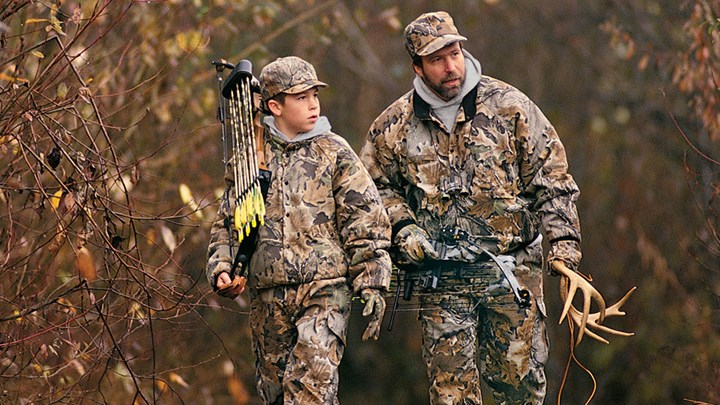
by Cody McLaughlin - Thursday, February 22, 2024

Rhode Island, a state steeped in hunting tradition, is celebrating our shared human roots this month through efforts to highlight the crucial role hunting serves in wildlife conservation and deer management in the state.
According to a press release from the state’s Department of Environmental Management (DEM), regulated hunting has proven to be the most cost-effective, efficient and successful method of controlling deer populations. At the same time, it provides the funding for DEM’s broader network of wildlife conservation efforts as established by the North American Model of Wildlife Conservation to ensure the species’ numbers fall in line with scientific carrying capacities and the ecological and social limits those capacities dictate. In fact, Rhode Island successful deer management efforts support a robust deer season, offering hunters the chance at an average of two antlered deer statewide and anywhere from two antlerless deer in the most restrictive zones and unlimited antlerless deer in Zone No. 4 where populations are strongest.
Hunting is also the most economical control option. In fact, the Rhode Island DEM’s Division of Fish & Wildlife Principal Wildlife Biologist Dylan Ferreira explained, “Other options such as translocation and fertility control are cost prohibitive and have limitations rendering them ineffective in most scenarios. Relocating wildlife is illegal in Rhode Island under most circumstances and can spread parasites and diseases to new locations.” Though chronic wasting disease (CWD) is not present in Rhode Island, he shared how it is spread primarily through the movement and transportation of live deer.
He also explained, “Fertility control comes in the forms of contraceptive medication or physical sterilization, with both considered unviable population control techniques when used alone due to low efficacy from multiple required dosages and the difficulty of capture. Both alternative options can lead to deer mortality from the stress of capture and require significant resources to capture, treat, sedate, operate on or translocate deer. Legal regulated hunting remains the best method for managing deer population growth.”
This economical and targeted control, in turn, allows biologists in the state to maintain a healthy deer herd that avoids many of the negative ecological and human impacts of overpopulated ungulates, including crop loss (deer love corn!), control of tick-borne diseases, nuisance complaints due to deer raiding flower beds and vegetable gardens, and the ubiquitous deer-vehicle collisions we see across the country and which cost Rhode Islanders an average of $6,717 per collision.
Collaborating with local landowners, municipalities, nongovernmental organizations (NGOs) and private entities, the DEM has endeavored in recent years to open lands to public hunting, aiming to curtail the negative impacts of overabundant deer populations. A shining example is the cooperative hunting program in Bristol, a town grappling with high deer collision rates and resident complaints. Since the program's initiation in 2023, Bristol’s deer harvest has nearly tripled, offering a promising solution to the age-old problem.
In fact, according to the most recent Rhode Island Hunter Sentiment Survey, most hunters hunt primarily for food. This reflects a common trend among hunters nationwide, largely driven by the explosion in outdoor media depicting the benefits of hunting for meat and the growing popularity of haute wild game cuisine, wild game recipe books and videos by renowned chefs and cooking influencers.
In fact, the state also shared that its 2022-23 deer hunting season yielded more than 32 tons of consumable venison, equivalent to about 130,000 meals. DEM praised hunters for reducing reliance on a complex and often misguided food system that relies on factory farming and shipping food thousands of miles before reaching dinner tables.
Lastly, an important consideration is the stewardship of not only our natural wildlife resources but the state’s economy that hunters support. According to DEM data, in 2023 alone, Rhode Island received $7,176,940 in funding for wildlife restoration from the U.S. Fish & Wildlife Service’s Wildlife and Sport Fish Restoration (WSFR) Program, which is funded by Pittman-Robertson funds. Hunters and anglers purchase approximately 70,000 licenses, permits, stamps and tags each year and contribute more than $235 million to Rhode Island's economy—or roughly half of 1 percent of Rhode Island’s entire $55.6 billion economy. Those are big numbers for a small state’s economy.
About the Author
Cody McLaughlin is a conservationist and conservative thought leader on public policy issues including hunting, fishing, gun rights, free-market tax and wage policy and the environment. He launched Trout Stream Studios as an executive producer for podcasts and livestreams in the hunting and veterans’ affairs spaces, including for the Congressional Sportsmen’s Foundation’s “The Sportsmen’s Voice” podcast.” A full-time digital media consultant, he serves on the board of the Alaska Outdoor Council (the Last Frontier’s State’s NRA Affiliate) and is a former board member and lead spokesman of the New Jersey Outdoor Alliance.
E-mail your comments/questions about this site to:
[email protected]
Proudly supported by The NRA Foundation and Friends of NRA fundraising.
